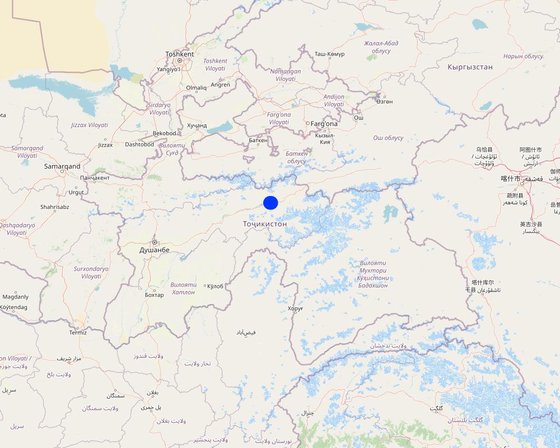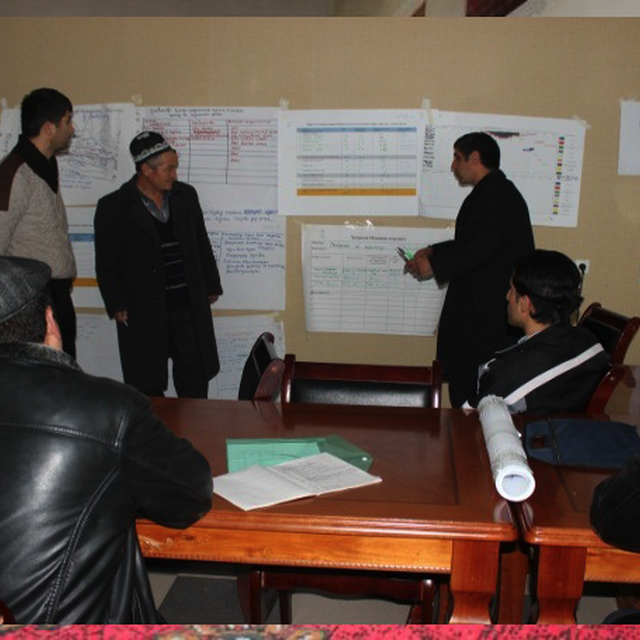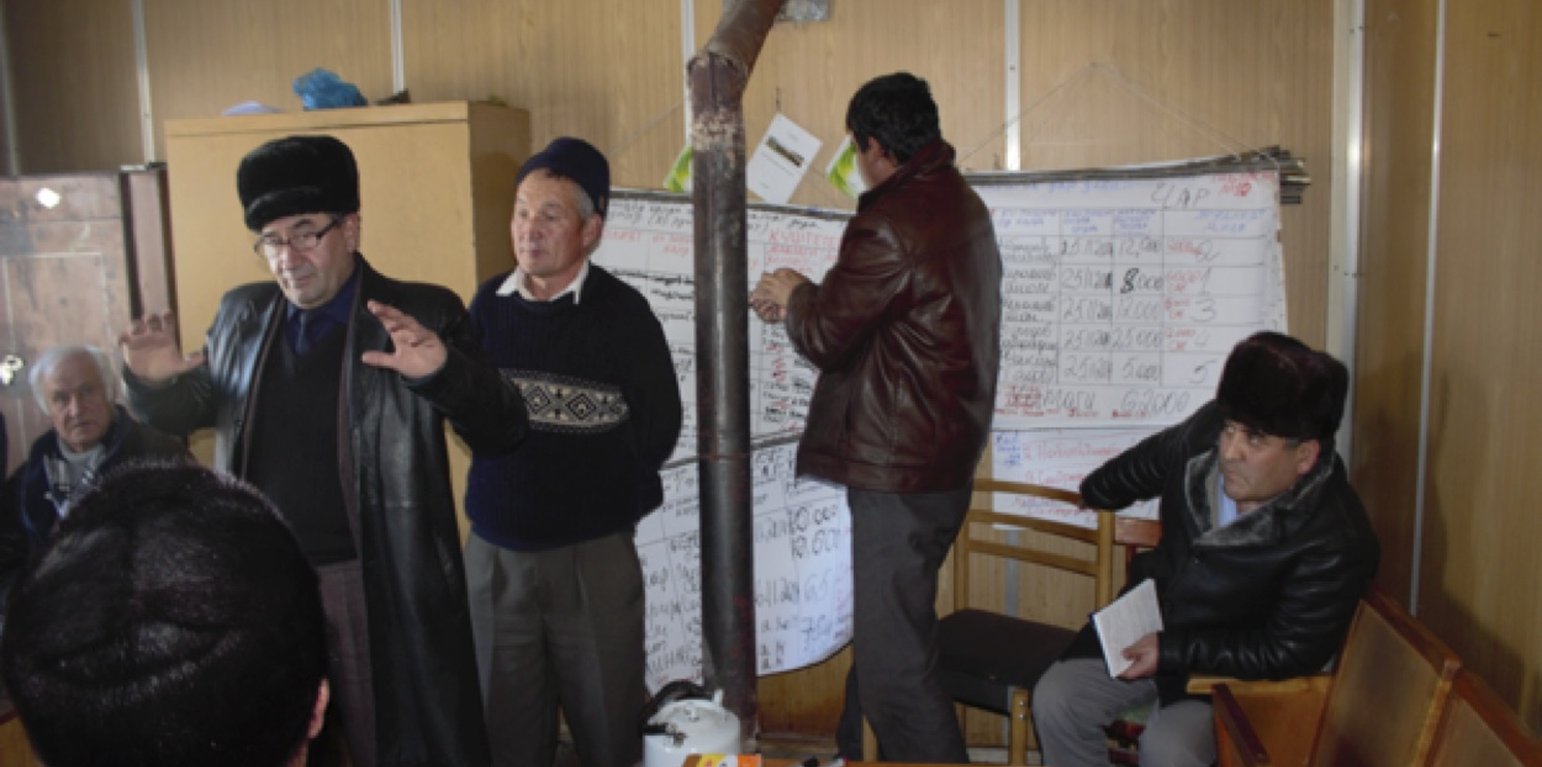Pasture and Livestock Management Plan
(塔吉克斯坦)
Накшаи Идоракунии Чорво ва Чарогох
描述
"Pasture and Livestock Management Plan" is a participatory approach which is guiding pasture users, members of Pasture User Unions and Pasture User Groups to develop their action plan on pasture and livestock management. The approach brings together stakeholders, who are involved at any stage in pasture management or can contribute to or impede the implementation of the pasture livestock management plan.
Pasture and Livestock Management Plan (PLMP) Approach is a participatory approach towards the development of a pasture plan with communities to ensure a sustainable use of pasture resources. It was especially designed for the needs of the Pasture User Union, a new structure allowed to establish at community level to implement better management of their pasture resources. Though a step-by-step analysis of the current situation a community will come up with detailed action plan for the following three years. The PLMP involves, but is not limited to, the establishment of a committee involved in preparation of the PLMP, as well as a stakeholder analysis and the determination of the carrying capacity of pasture resources by comparing the existing fodder resources and requirements for the fodder. Based on that analysis, an action plan will be developed with involvement of all stakeholders to reach an agreement on approaches and technologies to implement the interventions. The PLMP will lead to the development of the Action Plan based on the discussion between different stakeholders. In the process of the plan development with consideration of an expert a clear roles and responsibilities of all involved actors/stakeholder in a defined timeframe will be identified.
The main objectives is to support land users with development of actions, which contribute to the sustainable development of pasture resource and livestock development. The central focus is given to balance the need of the livestock owners to improve livestock productivity with compromising the environmental conditions for the next generations and ecosystem services. The planning process should contribute to better management of pasture lands, rehabilitation of degraded pastures, resolving any existing conflict over pasture use, awareness raising on the role of pasture land for ecosystem services and overall trends in development with regards to use and management of pasture resources.
The process is based on participatory methods with involvement of different stakeholders capturing main principles for land use planning. The process includes pasture users/livestock owners who are involved in day to day management of pasture lands, local government with related department to pasture use, land owners, different departments of local government such as forestry, land use committee, environmental protection etc.
The approach is conducted in three main stages: In the firs stage consultation with pasture users will be held to identify the need for development of a pasture plan. Then an inventory of all land resources, including pasture land and livestock numbers will be conducted. In the third stage a workshop will be conducted with involvement of all stakeholders, where the pasture plan will be developed. In the final stage of the pasture plan development an action plan with defined clear activities in a given frame and assigned responsible persons will be developed.
Land users, who also own livestock appreciate their involvement in the pasture development planning. They also like when their voice is taken into consideration in making any decision with regards to the pasture use.
地点

地点: PUUs established in Rasht Valley under ELMARLP, Rasht Valley/Lakhsh District, 塔吉克斯坦
选定地点的地理参考
-
71.047, 39.185
-
71.06762, 39.18054
启动日期: 不适用
终止年份: 不适用
方法的类型

Training on participatory "Pasture and Livestock Management Plan" (Boronov Ibrohim)
方法目标和有利环境
该方法的主要目的/目标
The main objective is to support land users with the development of actions, that contribute to the sustainable development of pasture resource and livestock development. The central focus is to balance the need of the livestock owners to improve livestock productivity without compromising the environmental conditions for next generations and ecosystem services. The planning process should contribute to better management of pasture lands, rehabilitation of degraded pastures, resolving any existing conflicts over pasture use, raise awareness on the role of pasture land for ecosystem services and overall trends in development with regards to use and management of pasture resources.
推动实施本办法所应用技术的条件
-
机构设置: The PLMP approach is specifically designed for the PUU, which are legally registered institutes under the governmental law. This enables the process to run continously.
-
参与者的的协作/协调: Depending on the leadership of the institutional structure, if well managed, it can enable collaboration among different stakeholders
-
法律框架(土地使用权、土地和水使用权): mainly used by the PUUs, which are are functioning in the framework of state law
-
政策: The plan is developed for the Pasture User Unions, which are legal structure responsible for pasture management at community level.
-
土地治理(决策、实施和执行): The approach will enable community members (PUUs) to become legal owners of the pasture resources according to the Pasture Law of the Republic of Tajikistan.
-
了解SLM,获得技术支持: Experts in the field are supported technically by project consultants, several trainings on the process and approach are conducted for them.
阻碍实施本办法所应用技术的条件
-
社会/文化/宗教规范和价值观: Communities are used to an ad hoc use of natural resources and therefore sometime not willing to structured planning processes in terms of use of pasture resources.
-
财务资源和服务的可用性/可得性: In the case that funding is not available from project side, it may hinder further implementation of the actions planned under the PLMP approach.
-
参与者的的协作/协调: The newly established PUUs do not have enough power to influence the institutes in which stakeholders who are not interested in the sustainable use of pasture resources work hinder the planning process.
相关利益相关者的参与和角色
该方法涉及的利益相关者及其职责
| 该方法涉及哪些利益相关者/执行机构? |
指定利益相关者 |
说明利益相关者的角色 |
| 当地土地使用者/当地社区 |
livestock owners and PUU members |
involved in direct process development and implementation of the approach |
| 社区组织 |
village organizations, pasture user unions |
also registered in the framework of the state law and are represented in the PUU. mainly involved in mobilization of the community to participate in the development and implementation of the plan |
| SLM专家/农业顾问 |
project consultants and technical staff |
facilitate the process of developing the PLMP approach, capacity building on the approach for the members of PUU |
| NGO |
locally registered public organizations which are directly involved in the natural resource and environmental management |
provide technical support to the community and land users; can also support with fundraising |
| 私营部门 |
entrepreneurs at local level |
co-funding of the implementation of some of the practices from the PLMP |
| 地方政府 |
local level government (sub-district authority), land use committee, committee of environmental protection, agriculture department etc., |
as one of the main stakeholders responsible for management of natural resource; can also provide overall supervision of the approach development; PUUs for which the PLMP is developed: legal structure under the Pasture Law of the Republic of Tajikistan. |
领导机构
Land Commttee
当地土地使用者/当地社区参与该方法的不同阶段
启动/动机
livestock owners, PUU members; consultation with livestock owners, facilitation the process of establishment of PUUs
计划
land users, PUU members, pasture experts
实施
PUU members and expert from project; consultation with stakeholders, conduct workshop and development of the plan
监测/评估
from project team and management of PUU
有关SLM技术选择的决策
决策是由......做出的
-
仅限土地使用者(自主)
-
主要是土地使用者,由SLM专家提供支持
-
所有相关参与者,作为参与式方法的一部分
-
主要是SLM专家,咨询土地使用者之后
-
仅限SLM专家
-
政治家和领袖
决策是基于
-
对充分记录的SLM知识进行评估(基于证据的决策)
-
研究结果
-
个人经验和意见(无记录)
技术支持、能力建设和知识管理
以下活动或服务是该方法的一部分
-
能力建设/培训
-
咨询服务
-
机构强化(组织发展)
-
监测和评估
-
研究
能力建设/培训
涵盖的主题
"Pasture and Livestock Management Plan" methodology, proposal development for fund raising, Environmental Land Management
咨询服务
During the project period continuos visits were organized to the project site to review the progress and provide advisory service. The project implmentation team consisting of different experts, including pasture, environmental specialists and monitoring and evaluation experts.
机构强化
描述机构、角色和职责、成员等.
Pasture User Union was established at sub-district level.
进一步细节
Different technical and administrative trainings were provided and the PUU was funded with certain amount for implementation of the PLMP approach.
监测和评估
The final section of the PLMP is monitoring and evaluation. At each stage a responsible person among the stakeholders is assigned to conduct the plan implementation. In addition, the project team also conducts monitoring of the approach.
融资和外部物质支持
SLM组成部分的年度预算,以美元计算
-
< 2,000
-
2,000-10,000
-
10,000-100,000
-
100,000-1,000,000
-
> 1,000,000
Precise annual budget: 不适用
World Bank in the framework of ELMARL - Environmental Land Management and Rural Livelihood project
已向土地使用者提供以下服务或激励
-
为土地使用者提供财政/物质支援
-
特定投入的补贴
-
信用
-
其它激励或手段
影响分析和结论性陈述
方法的影响
该方法是否有助于当地土地使用者,提高利益相关者的参与度?
It directly helped them to identify their status and understand their right to land use.
该方法是否帮助土地使用者实施和维护SLM技术?
All technologies planned under the approach as part of their action plan were later financed by projects to implement.
该方法是否缓解了冲突?
Roles and responsibilities identified all stakeholder and one of the objective to mitigate conflict brought under discussion conflict over pasture use and tried to solve it to some extent.
该方法是否有助于社会和经济弱势群体?
Women's role in livestock management was identified and empowered.
土地使用者实施SLM的主要动机
-
增加生产
-
增加利润(能力),提高成本效益比
-
减少土地退化
-
降低灾害风险
-
减少工作量
-
支付/补贴
-
规章制度(罚款)/执行
-
声望、社会压力/社会凝聚
-
加入运动/项目/团体/网络
-
环境意识
-
习俗和信仰,道德
-
提高SLM知识和技能
-
美学改进
-
冲突缓解
方法活动的可持续性
土地使用者能否维持通过该方法实施的措施(无外部支持的情况下)?
结论和吸取的教训
长处: 土地使用者的观点
-
active participation in the development of the plan
-
better understanding of the current situation with regards to pasture use and importance of pasture plan development
长处: 编制者或其他关键资源人员的观点
-
involvement of all stakeholders, especially land users and taking their knowledge and voice into consideration in decision making
-
building of the knowledge and opening a platform for collaboration between different stakeholders interested in sustainable management of pasture resources
弱点/缺点/风险: 土地使用者的观点如何克服
-
time consuming, requires resource in the short term
should be understand as a means of livelihoods and spend more time, improve understanding of better gain in a long term
弱点/缺点/风险: 编制者或其他关键资源人员的观点如何克服
-
financial resources
should design longer term project to attract funding before the approach becomes self sustained
-
low capacity of the stakeholders,
more trainings, sharing of experiences
-
human resources
More focus should be given to younger generation to build their capacity and involve them in the approach development
参考文献
审查者
-
Yacime Khadraoui
-
Maximilian Knoll
-
Joana Eichenberger
实施日期: March 23, 2018
上次更新: Aug. 22, 2024
资源人
-
Askarsho Zevarshoev (askarsho2006@yahoo.com) - SLM专业人员
文件编制者
机构
- Aga Khan Foundation (AKF) - 瑞士
项目
- Environmental Land Management and Rural Livelihoods (ELMAR)
主要参考文献
-
Pasture and Livestock Management Plan Manual: Available upon request





